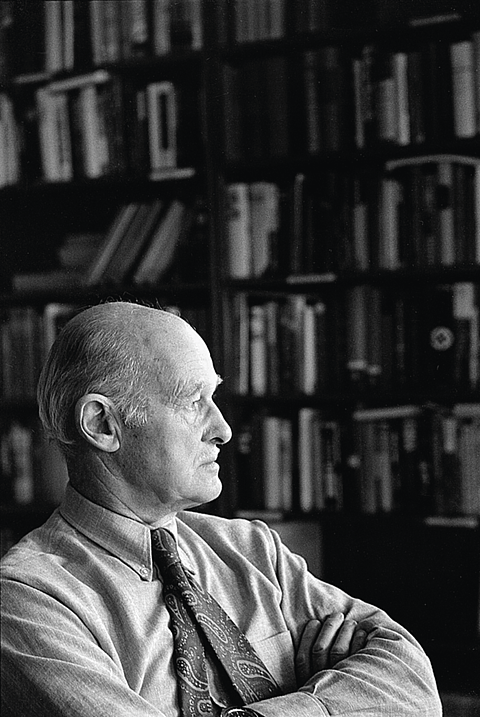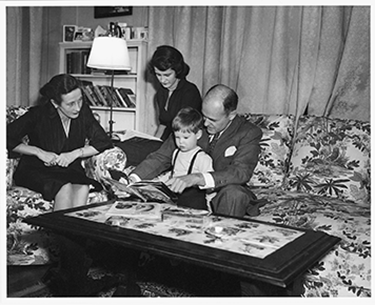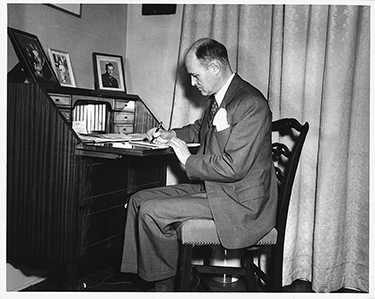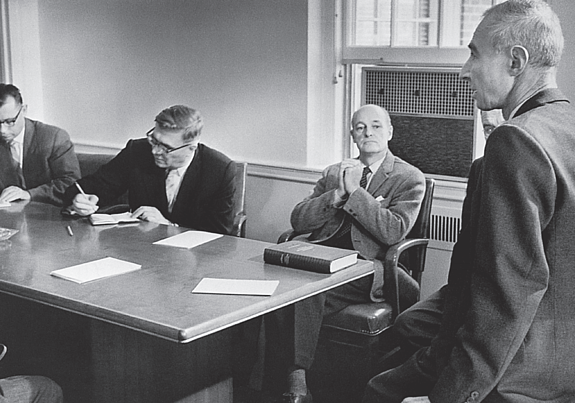On November 20, 1958, J. Robert Oppenheimer (right), Director (1947–66) of the Institute for Advanced Study, and George F. Kennan (center), then Professor in the School of Historical Studies and former Ambassador to Russia, conferred with nine Soviet educators who were on a five-week stay in the United States. At left is Aleksei I. Markushevich, editor of the Russian pedagogical encyclopedia and head of the delegation. The book on the table is an autographed copy of Markushevich’s volume on the theory of analytic functions, which he presented to Oppenheimer. The conference, which was held in Oppenheimer’s office, was principally to acquaint the Soviets with the operation of the Institute.
At the time the photograph was taken, Kennan was writing his two-volume, one-thousand-page Soviet-American Relations, 1917–1920. Kennan’s long connection with the Institute began with an invitation from Oppenheimer to come to the Institute as a Visitor in 1950; he was appointed to the Faculty in 1956. Below, Frank Costigliola, a Member in the School of Historical Studies who is working on a biography of Kennan, writes about how the Institute permitted Kennan the time for study and reflection that allowed him to negotiate “a workable balance between his scholarship and engagement with current affairs,” although not without some internal strife.
Torn between his obligations to scholarly endeavors and to discussions of current events, Kennan turned to Oppenheimer for advice in 1958 when Kennan was still at Oxford, having recently delivered his Reith lectures in which he called for negotiations with Moscow to reunify Germany and reduce nuclear weapons. Oppenheimer replied, “If the Institute is to mean what it can to you, it must surely mean that you are free to return here with no clear notion of what you will do next, and with the confidence that here you will find, in terms of the years that you have spent here, and perhaps with some help from us, a gradual settling of the issues.”

“True scholars often work in loneliness, compelled to find rewards in the awareness that they have made valuable, even beautiful contributions to the cumulative structure of human knowledge, whether anyone knows it at the time or not.”1
These words from George F. Kennan are carved into Elyn Zimmerman’s curved granite and steel sculpture overlooking the pond between Fuld Hall, Kennan’s scholarly home, and the Institute Woods, where he loved to walk. Nearly every phrase of the quotation reflects some aspect of his personality and work. He ranked as a “true scholar,” publishing over twenty books, winning nearly every relevant book prize, and receiving many honorary degrees––all this in a career begun in the second half of his 101-year life. Much of his writing and thinking centered on Russia. “Your gifts are unique in the world,” Isaiah Berlin penned in 1965. “Literary, intellectual, moral, political: nobody in the Western world . . . can detect, as you can, the spirit of Russia, the smells of (old) Russia.” 2
Despite such acclaim, Kennan spent much of his life, as page after page of his newly opened diary testify, in “loneliness.” In the 1930s–50s, he felt cut off from close association with Russians and with Russian culture because the Kremlin’s secret police restricted contact with foreigners. His yearning had the insistence of a physical need. He wrote of his returning to Russia “like a thirsting man on a stream of clear water.”3 Living in Riga in 1932, he felt immersed in the pre-Revolutionary society of Chekhov’s stories. “I drink it all in, love it intensely, and feel myself for a time an inhabitant of that older Russia.”4 Kennan’s loneliness stemmed also from his feeling out of step with the march of power in Washington. Until early 1946 and the circulation of his famous “Long Telegram,” his sounding the alarm about the “Soviet threat” went largely unheeded. There followed three halcyon years in which he became a major player in formulating U.S. policy in the Cold War. By 1949, however, he was growing increasingly uncomfortable with Washington’s focus on military buildup rather than diplomacy that might reduce tensions with Moscow. Despite his service as ambassador to the Soviet Union in 1952, ambassador to Yugoslavia in 1961–63, and as a short-term consultant, Kennan, though still respected, was excluded from Washington’s policymaking circle. Still another aspect of his loneliness arose from his feeling, as he put it in 1988, like “an expatriate in time.”5 He felt more in tune with the eighteenth and early nineteenth centuries. He criticized contemporary American society as dangerously atomized, commercialized, and beholden to technology. In a 1955 diary entry, he confided that even his friends did “not know the depth of my estrangement, the depth of my repudiation of the things [the American public] lives by.”6

An organic conservative, Kennan treasured continuity across generations and the community nurtured by small towns. He lamented how the automobile had dispersed the intimate clusters of homes and businesses formerly served by rail lines. What had cohered instead was suburban sprawl, which separated neighbors and destroyed farmland. He rued the loss of human contact when the Princeton telephone system shifted from operator-assisted to self-dialed phone calls. He prized networks of responsibility, whether they linked mutually respectful people in a hierarchy or humans interdependent with their environment.
Inspired by Edward Gibbon, Kennan aimed for literature that was elegant, even “beautiful.” The attention to aesthetics complemented his attunement to the senses and to emotions. Whether writing for his diary or the State Department, he crafted like a playwright. The substance of his political analysis was certainly subtle, discerning, and informed. His most influential writing went further, however, by also delineating moods, personalities, and scenarios. He deployed rhetorical strategies and dramatic tension. Speaking to the P.E.N. club, he endorsed Berlin’s citing of Virginia Woolf’s belief that underlying “the so-called economic and political realities” was the more “genuine” world of individual relations and of the “colors, smells, tastes, sounds, and movements, the jealousies, loves, hatreds, passions, and rare flashes of insight.” Kennan believed that writing history “gracefully and effectively” contributed to the “scientific essence of the exercise.” Graceless writing, moreover, no matter how conscientious,“would tend to die in the libraries.” That was a fate he dreaded. He cared deeply about his audience, about the reach of his pen.7
How did this devotion to scholarship and beauty, this susceptibility to loneliness and concern for audience, play out over six decades at the Institute? In February 1950, J. Robert Oppenheimer, then Director of the Institute, invited Kennan to become a Member. The latter gratefully accepted, adding, “You have become my intellectual conscience.”8 The two men shared respect for the humanities as well as the sciences. They valued rigorous thought expressed with elegant style. They tended toward a melancholy view of life and sometimes gave way to emotion. Each bore some responsibility––Kennan with his dire warning about the Soviets in the Long Telegram, Oppenheimer with his direction of the atomic bomb project––for the darkening of the Cold War. Both deplored this trend and were frustrated in trying to keep it in check.
In 1955, the School of Historical Studies voted unanimously to offer Kennan a Faculty position. Other Faculty members, however, most of them from the School of Mathematics, demurred. The final vote was thirteen to five in favor. Though Kennan would rise to the top in terms of prestige at the Institute––after all, the only other people quoted on the sculpture are Albert Einstein and founder Abraham Flexner––the controversy over his appointment chafed at him. He later confided that a principal reason for the “appalling accumulation of detail” in his first scholarly work, the two-volume, onethousand-page Soviet-American Relations, 1917–1920 (1956–58), was to forestall criticism for superficiality from colleagues, particularly those at the Institute.9 Two letters of evaluation written at the time of his hiring point to why Kennan’s historical scholarship was controversial. He published Soviet-American Relations in part to counter Moscow’s criticism of U.S. intervention in the Russian civil war. Gordon A. Craig, a Professor at Princeton University at the time (and a former Member of the Institute’s School of Historical Studies), wrote that despite Kennan’s brilliance, his “thinking is not the thinking of a professional historian.” He was apt to “stop being the objective historian and slip into the role of the polemicist, arguing the case of 1950 from the circumstances of 1917.”10 That present-mindedness was what impressed Theodor E. Mommsen of Cornell. “Not many people in this world” were as “profoundly humane” as Kennan, Mommsen declared. He found particularly praiseworthy the man’s “deep sense of moral and civic responsibility.” 11 Critics weighed in with their own judgments. In addition to largely rave reviews in the historical journals, Soviet-American Relations garnered the Pulitzer Prize, the National Book Award, the Bancroft Prize, and the Francis Parkman Prize for literary distinction in history.
Kennan appreciated that the Institute’s facilities for scholarly work were “unsurpassed anywhere in the world.”12 He and his wife, Anneliese, loved living in Princeton. Yet he continued to feel a bit out of place. He agonized about his career. Where did he––where should he––position himself on the spectrum between the scholar focused on the past and the man of affairs? He felt attracted and repelled by both poles. His 1957 Reith lectures, which called for negotiations with Moscow to reunify Germany and reduce nuclear weapons, generated enormous buzz when they were broadcast from Oxford by the BBC. In 1958, he wrote Oppenheimer: “Not one person in a hundred who approaches me is in any way interested in my work as an historian.” Instead they saw him either as an irresponsible dreamer or as a rescuer from the Cold War. Kennan felt torn. He prized his privacy. Yet he was also entranced by his audience. He now had “a voice which is listened to by millions of people with interest and respect. . . .There are not so many voices of this sort in our western world today.” He could not abandon those “who have confidence in me.”13 Then again, playing a public role could undermine his commitment to the Institute. He had accepted the Faculty appointment with the understanding that, as Oppenheimer had reported to the Trustees, he would “make the business of scholarship his life work.” (The pledge had specifically omitted a “commitment to refuse high political office.”)14 Kennan worried about losing “the very detachment and disinterestedness” that authenticated his voice. Oppenheimer advised him to take his time deciding.
By late 1959, Kennan, encouraged by Robert F. Goheen, President of Princeton University, was contemplating a run for the U.S. Senate. More than ever he felt a “public responsibility” to the “thousands of people” in America, Europe, and Asia, especially young people, “who look to me to do my part” in solving world problems. The Institute now seemed too “isolated a position” from which to address pressing issues. The Director could not, however, keep a Professor waging a political campaign on the payroll. Kennan countered that since joining the Faculty he had produced “a not discreditable record of scholarly work”––enough work to justify his taking off most of 1960 to campaign. Oppenheimer would not relent. The Director probably recalled that the caveat in Kennan’s pledge specified that he would not “refuse” high office. It said nothing about seeking such office. The would-be candidate had no other means to support his family. The larger problem, Kennan emphasized, was that democracy suffered from the limited pool of candidates who could afford to run. “This state of affairs makes me very unhappy,” he told Oppenheimer.15

The career of a Senator Kennan is fascinating to contemplate. He would likely have tried to bring his scholarly erudition to bear in Senatorial discussion. He would have crafted beautiful speeches. He would have argued for a different approach to the Soviet Union. He would have worked to develop an audience informed about world affairs. But how, one wonders, could he have avoided the inner loneliness and turmoil resulting from the conflict between a public persona acceptable to voters and a private self that “repudiated” much of those voters’ culture?
Kennan never had to merge those personae. Instead, for most of the next four decades he stayed at the Institute, where he produced beautifully written, thoroughly researched works of history, volumes of memoirs, and stirring arguments for nuclear disarmament. He negotiated a workable balance between his scholarship and engagement with current affairs. Even so, in his last years he “didn’t find as many connections with the Institute as earlier,” a longtime associate would later recall. “He felt more isolated.”16 Nevertheless Kennan’s commitment endured. At the Institute’s celebration of his centenary on February 18, 2004, he made only one point in his brief remarks: “I have never regretted” the dedication to scholarship, he said. “I have regarded it as a privilege to consider myself a member of the Faculty of the Institute.” 17
1. Comments by George F. Kennan at the State Department, October 6, 1994, Kennan papers, box 181, Mudd Library, Princeton University.
2. Berlin to Kennan, September 4, 1965, Kennan papers, box 5, ibid. (emphasis in original).
3. Kennan, Sketches from a Life (Norton, 1989), 363
4. Kennan, Memoirs 1925–1950 (Little, Brown and Company, 1967), 190
5. Kennan, At a Century’s Ending (Norton, 1996), 31.
6. Kennan diary, October 21, 1955, box 233, Mudd.
7. Kennan, “History as Literature,” Encounter, April 1959, 15, 11.
8. Kennan to Oppenheimer, June 5, 1950, Kennan papers, box 37, Mudd.
9. Lee Congdon, George Kennan: A Writing Life (ISI Books, 2008), 73–74.
10. Craig to E. L. Woodward, March 18, October 16, 1955, Faculty Series, box 19, Kennan folders, The Shelby White and Leon Levy Archives Center, Institute for Advanced Study.
11. Mommsen to Ernst Kantorowicz, March 17, 1955, ibid.
12. Kennan to Martin E. Segal, January 15, 1976, ibid.
13. Kennan to Oppenheimer, February 21, 1958, ibid.
14. Excerpt from Minutes of the Board of Trustees meeting, November 15, 1955, ibid.
15. Kennan to Oppenheimer, December 14, 1959, ibid.
16. Author interview, October 22, 2009.
17. Symposium in Honor of George F. Kennan, February 18, 2004, Audiovisual Collection, The Shelby White and Leon Levy Archives Center, Institute for Advanced Study.
